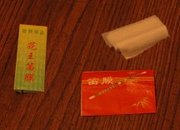Di Zi
|
|
The Di Zi (笛子, pinyin dí zi), is a very unique kind of Chinese transverse flute. It is also known as the Dizi, or simply the Di, and has varieties including the Qudi and Bangdi. It is sometimes also known as the hengdi.
These names are likely to have multiple spellings, too, depending on the transliteration used to convert from Chinese names. Nonetheless, Dizi seems to be the most popular name (and written form) used in the West.
The di zi is a major Chinese musical instrument, popular not only in Chinese Folk Music, Chinese Operas and Chinese Orchestras, but also used in music exported to the west. The di zi has a deep, rich history, and a lasting appeal. Traditionally, the di zi has also been popular among the Chinese common people, since it is simple to make, easy to carry, and of course, beautiful when played.
Most di zi are made of Bamboo, which explains why di zi are sometimes known by simple names such as 'The Chinese Bamboo Flute'. However, 'bamboo' is perhaps more of a Chinese instrument classification like 'woodwind' in the West.
In truth, although bamboo is the common material for di zi, it is also possible to find di zi made from other kinds of kinds of wood, or even from stone. Jade di zi (or yudi) are popular among both collectors interested in the almost magical beauty of jade di zi, and among professional players who seek an instrument with look that matches the quality of their renditions.
The di zi is not the only bamboo flute of China, although it is certainly distinctive. Other Chinese bamboo instruments include the Xiao, the Guanzi, and the Bawu.
The Dizi's uniqueness
Whereas most simple flutes have only a blow-hole (an embouchure, known as Chui kong in Chinese) and finger-holes, the di zi has very different additional hole, called a Muo kong, between the embouchure and finger-holes. A special membrane or Di mo, made from an almost tissue-like shaving of bamboo, is made taut and glued over this hole, traditionally with a chinese garlic-based glue called Ar Jiao. Garlic juice or glue sticks may also be used to adhere the dimo. This application process, in which fine wrinkles are created in the centre of the dimo to create a penetrating buzzy timbre, is an artform in itself.
The Muo kong has a distinctive resonating effect on the sound produced by the di zi, making it brighter and louder, and adding harmonics to give the final tone a buzzing, nasal quality. Di zi have a relatively large range, covering about two-and-a-quarter octaves.
Di zi are often played using various advanced techniques, such as circular breathing, slides, popped notes, harmonics, "flying finger" trills, multiphonics, fluttertonguing, and double-tonguing. Most professional players have a set of seven di zi, each in a different key (and size). Additionally, master players and those seeking distinctive sounds such as birdsong may use extremely small or very large di zi. When all of these qualities are combined by a master player, the di zi can be a very versatile, unique, and truly beautiful instrument.
Origins
There are many suggestions for the source of Di zi. While some suggest that the Yellow Emperor ordered his government official to make the bamboo musical instrument, others believe that Di zi was imported into China during the Han Dynasty.
Recently, archaeologists have discovered evidence suggesting that the simple transverse flutes (though without the distinctive Muo Kong of the di zi) have been present in China for over 8000 years. Fragments of bone flutes from this period are still playable today, and are remarkably similar to modern versions in terms of hole placement, etc. These flutes share common features of other simple flutes from cultures all around the world, including the Ney, which was depicted in Egyptian pyramids. In fact, recent archeological discoveries in Africa suggest that the history of such flutes may date back a very long way in human history indeed.
Styles
Contemporary di zi styles are divided into two: The Style of North and the style of South, each style having different preferences in di zi skills. In Northern China, for example, the Bangdi is used to accompany the Bang Zi opera, with a sound that is bright and vigorous. In Southern China, the Qudi accompanies the Kunqu opera, with a more mellow, sentimental tone.
For more information on other Chinese musical instruments, visit Music of China.zh:笛子 ru:Ди


